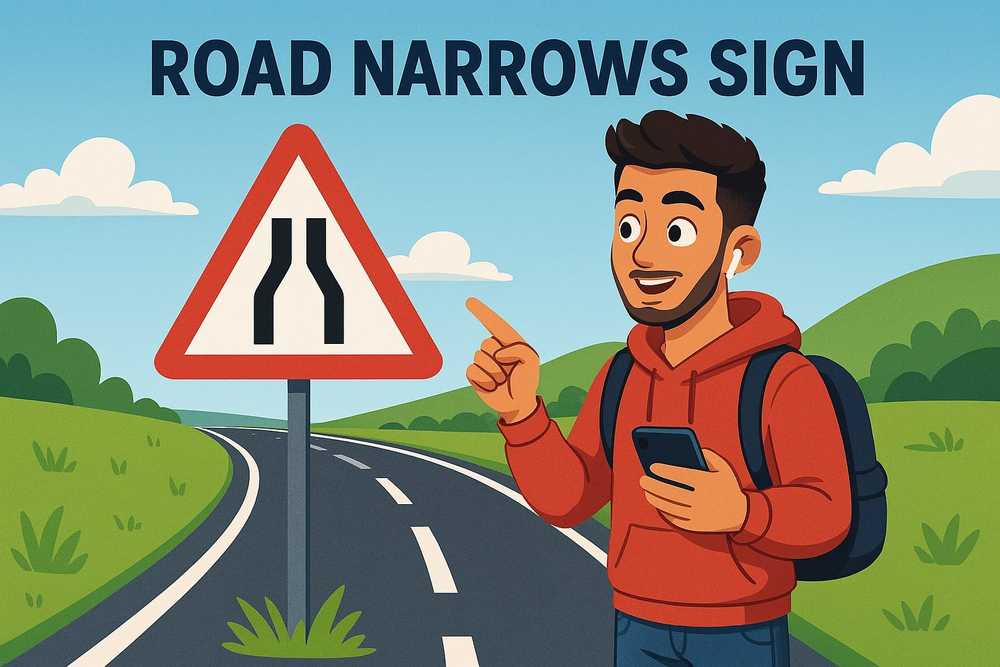What Does The Road Narrows Sign Indicate?
All Warning Signs, from Crossroad Signage to the Road Narrows Sign, play a vital role in UK traffic safety. They deliver real-time updates, enforce rules—like the No Entry Road Signregulate traffic flow, and highlight hazards. As such, every driver must recognize these common symbols with ease.
The Road Narrows Sign has for a long time been important to the UK traffic system. Along with improving traffic safety, it can also keep the traffic flowing in cases of temporary road construction. This sign signifies that the road you are on is about to become skinnier. That is, it will lose some width giving you less room to maneuver your vehicle. Therefore, you should make some adjustments when driving to stay safe.
When seeing the Road Narrows Sign, the driver should be prompted to slow down for better control. Drivers should also be prepared to welcome merging traffic, or if possible, to pass other cars but with extreme caution.
There are variations of the Road Narrows Sign. For example, the road might narrow on the left or right side only, or it could narrow on both sides. Look closely at the sign to know what part of the road will narrow so that you will know what changes to expect.
How Does It Help Drivers Navigate Safely?
The Road Narrows Sign alerts the driver to a sudden road change that could be hazardous. It is common on single carriageway roads that quickly narrow and make passing another vehicle unsafe. Therefore, when seeing this sign on the road, the driver must slow down and become more alert to their surroundings. Slowing down on narrow roads and driving more defensively minimizes the risk of accidents and makes for safer driving.
Types of Road Narrowing Situations
Temporary Narrowing (construction zones)
Road signs are placed on motorways and other roads in construction zones to protect drivers and workers. The Road Narrowing Sign is one that is often used to indicate a change in the road because of road work. These signs are meant to alert drivers that they will need to slow down because the road has been temporarily narrowed to provide room for road construction. It is often used in conjunction with Road Work Signs such as line painting or delays possible signs.
Permanent Road Narrowing (old roads, countryside)
When you’re driving through the countryside of the Scottish Highlands or visiting the medieval towns of Devon, England, you’ll more than likely have to drive on many narrow roads. These are often older roads and therefore are more narrow because they weren’t built with the motor vehicle in mind. When you’re approaching a narrow country road, the Road Narrows Sign can serve as a warning so that you can get mentally and physically prepared.
Visual Characteristics of This Sign
Visually, the Road Narrows Sign adheres to the standard Warning Signs format from the UK Highway Code: an equilateral triangle with a bold red border. Its central graphic clearly shows the direction of taper—both sides or only one—so you instantly know what narrowing lies ahead.
Similar Signs And How to Differentiate
The Road Narrows Sign is similar to other Highway Code signs. In appearance, it looks and is often confused with the Dual Carriageway ends sign, which warns drivers that the dual carriageway is ending and they should be prepared to merge with traffic. Although they look the same, their meaning is completely different. You can differentiate between the two by the illustrations. On the Dual Carriageway sign, the two lanes become one. With the Road Narrows sign, the two lanes remain separate.
Similar signs warn of structural or design road problems such as warning signs for sharp bends in the road, double bends and hidden dips.
Driving Safely When the Road Narrows
Adjusting Your Speed And Position
You should always drive at a speed in which you feel comfortable and in control of your motor vehicle. This is even more true when the road you are driving on narrows. Along with slowing down for your safety and the safety of the surrounding cars, it is also advisable to use your side mirrors to ensure you are staying on and not edging off of the road.
Common Mistakes When Dealing With Narrow Roads
Inexperienced drivers can become nervous and panic when they see the Road Narrows Sign. You should always remain calm and simply make sure that you are comfortable with your driving speed. In addition to panic and driving too fast on a narrow road, another common mistake is misjudging the width of the road. That is, the driver has a problem gauging whether the narrow lane is wide enough for their car. Therefore, they might get too close to the shoulder of the road or even veer off of the road when there is no shoulder because they are not experienced with spatial awareness and driving and they worry they might collide with another vehicle.
When on a narrow road, keep your eyes open for a safe passing place. You just might need it if you and another car come face to face and someone needs to pull over and let the other car go through. Many times, narrow roads are not paved so you’ll possibly have to slow down to a crawl to drive through gravel or crushed stone safely. On these country roads you might be delayed if you get behind a herd of cows or a combine. In snowy or rainy conditions, driving on an older and narrow road can be even more tricky, so drive carefully.
Finally, give yourself extra time if you have to drive on a narrow road. Of course, you’ll need the extra time because you’ll drive slower, yet still, you might get stuck behind another vehicle and being patient will keep you safe. If you face ongoing traffic, be courteous and communicate with the other driver to decide who is given priority. No matter what, remember that your safety is of utmost importance.
Passing the Driving Test: Road Narrows Scenarios
How to Approach This Sign In The Practical Test
Preparing to Get Your UK Driving Licence means mastering this sign’s meaning. In your practical exam, you may need to articulate that the Road Narrows Sign calls for a speed reduction and cooperative navigation with other drivers.
Questions on Road Narrowing in Theory Exams
Of course, you might also be asked to identify the Road Narrows Sign on your theory exam. You might be shown pictures of the sign and given a list of possible answers to choose from. There is no question that you can expect the Dual Carriageway Ends sign to be one of the options. But now that you’ve read this article, you’ll know better than to choose that one. Another possibility is that you’ll be asked to look at the sign and answer whether the road will narrow on the left, the right side or both.
Be sure to know the highway code rules as it pertains to narrow roads. Highway Code Rule 154 is a good rule to study as it covers this topic. To test your knowledge of this driving concept, you might be asked if you should drive at the same speed or reduce your speed when entering a narrow road. Of course, the answer is to reduce your speed. Another possible question would be about the right away on narrow roads. In truth, no one actually has the right away and this is where kindness and respect for other drivers will be important. However, in terms of driving etiquette, you’ll typically yield or give way to the vehicle that reached the median point first. They might even throw in an easy question to see if you know who you might be sharing a narrow road with. In addition to other cars, you might encounter pedestrians, cyclists, farm equipment, animals, etc. Consequently, on a narrow road you have to drive slow enough to stop suddenly if necessary.
Conclusion: Why Road Narrows Signs are Essential for Drivers
In summary, Road Narrows Signs are indispensable to safeguarding narrow-road travel. They alert you to imminent width changes, allowing you to approach with assurance rather than entering blind and risking collisions. Alongside UK Low Bridge Signs and other Warning Signs in the UK Highway Code, they uphold smooth traffic flow and conscientious driving habits, helping you avoid delays, damage, and fines.







